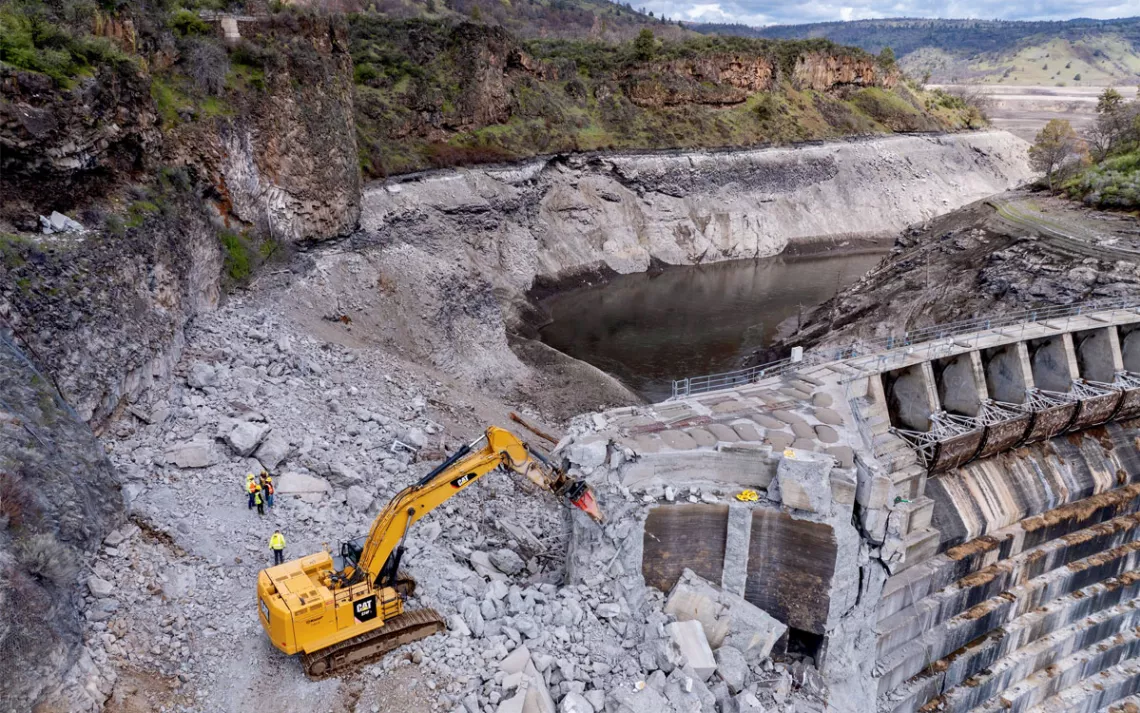Remaking the Klamath River
The largest dam-removal project in US history restores a once-great salmon migration route

An excavator chips away at the Copco 1 Dam shortly after the drawdown of the reservoir last January.
Over a hundred years ago, the Klamath River was caught up in the audacious endeavor to tame the West. Engineers built the Klamath Hydroelectric Project over a 60-year period starting in 1902, harnessing hydropower for a growing region. Six dams were built on a 55-mile stretch of river flowing through the shrubby basalt landscape of Southern Oregon and Northern California.
Within a few short decades, the dams came to be seen as part of a fixed landscape—inevitable even. But of course, infrastructure projects and landscapes aren’t fixed. Rivers change course, bridges collapse, and even mountains move—acts of God, or nature, or human failing.
The deliberate dismantling of a human monument can be a complicated task, requiring a clear-eyed assessment of the benefits and harms. It requires imagination and those with longer memories, such as the tribes who have lived in this region for millennia. The decommissioning of the four main dams on the Klamath River over the past two years—the largest dam-removal project in US history—proved that it can be done.
The dams had brought the magic of electricity to an isolated region. But the dams were a slow-burning emergency for those whose lives and identities had long been braided with the river—including the Tolowa, Yurok, Hupa, Karuk, and Shasta peoples as well as the Klamath Tribes (Klamath, Modoc, and Yahooskin-Paiute).
The Copco 1 reservoir, created in 1918, displaced ancestors of the Shasta and submerged their treasured lands. The construction of Iron Gate, the last and most downstream of the dams, effectively cut the Klamath watershed in half. In the dams’ chokehold, the river’s abundant salmon—Chinook, coho, and steelhead—began to flag.
Tribal advocates and fishermen started calling for the dams’ removal in the 1980s, but it wasn’t until 2002, when disease killed an entire generation of fall Chinook salmon in the lower reaches of the Klamath, that a movement cohered. Though the dams were not directly responsible, to many people, the fish kill warned of a river dangerously out of balance.
That the dams finally came down is thanks to a coalition of tribes, fishermen, and environmentalists who would not stop imagining the Klamath flowing freely. This included families with three generations of activists. Some people who fought for the vision did not live to see it.
The coalition’s campaign for dam removal—the caravans to corporate headquarters, the public testimonies, the careful scientific research, the uncomfortable meetings in which disparate stakeholders hashed out their differences—took decades. In comparison, the unmaking of the Klamath Hydroelectric Project happened swiftly. It started in October 2023 with the removal of the Copco 2 Dam. In January 2024, the drawdown of the reservoirs began in tandem. Controlled blasts blew out plugs at the base of the John C. Boyle and Copco 1 Dams.
Farther downstream, Iron Gate’s namesake gate cranked open. As the reservoir levels ebbed, a series of bathtub rings marked history. Strands of aquatic vegetation ringed the receding shores, then dried a ghostly, sallow-white. Great muddy cliffs sloughed away. The new landscape glistened darkly, like a half-baked chocolate cake. Tributary confluences emerged. The river found its channel.
Meanwhile, restoration crews pressed acorns into the soft ooze. Helicopters rained seed across areas too dangerous or remote to access by foot. By spring, the reservoir blushed with the fuzz of new growth. Spring gave way to summer, and the dams diminished. Crews blasted concrete, scooped earth and rubble, and transported load after load after load. By September, the Klamath was fully free.
Less than three weeks later, a pair of fall Chinook salmon were discovered spawning in a creek above Iron Gate. More than 100 made it all the way to a tributary in Oregon, above all four of the dam sites—an astounding reminder of nature’s resiliency when given half a chance.
The dismantling of the dams signals much more than the removal of physical fish barriers. To reconnect the river is to plug in life support, to couple past with future, to reenergize an ancient circuit. Once again, ocean energy stored in salmon flesh and bones can nourish the forests along the Klamath’s veins and capillaries. Once again, the river can transport silt and sand downstream, and trees can fall across creeks and trap those particles to create nursery pools where young fish flourish before they brave the broad river and embark on their ocean lives.
That is the hope, although Mother Nature offers no guarantees. The dams were just the largest and most visible of the cuts that have injured the Klamath River, which has also been polluted by agricultural runoff, depleted from water diversion, and marred by mining.
Now the task is to work with the Klamath and aid in its further healing. It’s a good cause, one requiring humility and cooperation—the hallmarks of a new restoration age
The Dismantling
The Klamath River Renewal Corporation, a nonprofit formed to oversee the dam-removal and restoration project, contracted with Kiewit, a construction and engineering firm, to take down four dams and their associated infrastructure. Each dam required a different strategy.

Photo by Whitney Hassett of Swiftwater Films, which has been chronicling the restoration of the Klamath.
An excavator chips away at the Copco 1 Dam shortly after the drawdown of the reservoir last January. Crews used small, controlled blasts to break up the concrete arch dam, which stood 126 feet tall and spanned 415 feet across the river.

In late August, the cofferdam at Iron Gate was breached, freeing the Klamath River for the first time in over 100 years. It took about four months for crews to remove approximately 1 million cubic yards of earth from the massive structure. The gate tower, on the left, was the last piece to be removed.
Return of the Salmon
Removing barriers on the Klamath River should give anadromous fish a much-needed boost. But the activities of dam removal caused short-term changes in the river that threatened the very fish the project was intended to help. Over the decades, the dams had trapped over 13 million tons of sediment. Draining the reservoirs released this material, mostly dead algae, into the river. For this reason, the drawdown of the reservoirs was planned for January 2024, when there were fewer fish in the river’s main stem. As expected, the torrent of sediment-packed water caused dissolved oxygen levels to temporarily plunge.

Sign up to receive Sierra News & Views
Get articles like this one sent directly to your inbox weekly.
With this action you affirm you want to receive Sierra Club communications and may vote on policy designated by the Sierra Club Board.

Over several chilly days in late December 2023, teams from Karuk Tribe Fisheries and Resource Environmental Solutions, a private company, captured juvenile coho salmon in the river and relocated them in tributary creeks, where they would be safe from the surge of sediment-laden water.

Over the past two years, the Oregon Department of Fish and Wildlife has been collaborating with the Klamath Tribes and other tribal, state, federal, and NGO partners to release spring Chinook salmon into the upper Klamath Basin. Tracking where they go and how they fare will help inform future habitat restoration.

Chinook salmon were discovered spawning above the former dam sites less than three weeks after the river was fully freed.

A fall Chinook salmon leaped up Puppy Falls in Indian Creek, a tributary of the Klamath River.
Let a Thousand Flowers Bloom
Resource Environmental Solutions is overseeing the restoration of the reservoir footprints—2,200 acres in all. Such a monumental project requires millions of seeds and years of planning. During the year before the drawdown, crews removed invasive vegetation and planted native trees and shrubs on a wide strip along the reservoirs’ shores.

In fall 2023, crews gathered thousands of acorns along a tributary of the Klamath River. Some were planted directly into the mud following the reservoirs’ drawdown, while others were germinated in pots.

Poppies and lupines bloomed in the reservoirs’ footprints in May 2024, just a few months after they were emptied. The vegetation will help prevent invasive species from colonizing the newly exposed soil. The planting will continue for several years.

Alauna Grant casts seeds onto the newly exposed mud behind the Iron Gate Dam. Tribal crews have worked alongside teams from Resource Environmental Solutions to plant nearly 100 native species in the reservoirs’ footprints.
Rebirth
The Klamath River winds freely through the reach above the former Iron Gate Dam, the shadow of the reservoir still visible. Dam removal alone won’t fix the Klamath River, though the speedy return of salmon to their historic habitat is a hopeful sign. Much work remains to restore habitat throughout the 12,000-square-mile watershed. This project offers an opportunity to inform future dam removals, and scientists will track the changes and follow fish for years to come.
In 2019, the Yurok Tribe passed a resolution granting the Klamath River personhood. In essence, it recognizes the river’s right to exist uncompromised. Such an idea also suggests a way of relating to the river—not as a resource to be harnessed and exploited but as a being to be cherished, protected, and respected.

 The Magazine of The Sierra Club
The Magazine of The Sierra Club



